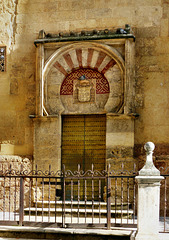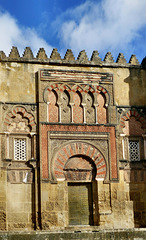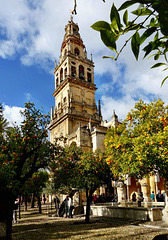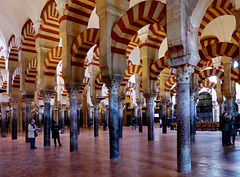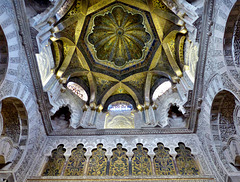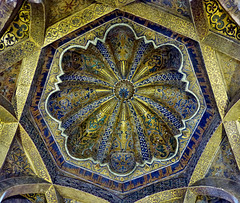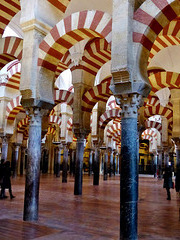
Mudejar art and architecture
Toledo - El Cristo de la Luz
| |
|
|
In 192 BC, the Romans conquered the area and founded the outpost Toletum. Due to its iron ore deposits, Toledo developed into an important settlement. Since the first barbarian invasions, the ancient walls were reinforced. In 411 the Alans and later the Visigoths conquered the city. Toledo was the capital of the Visigoths' empire from about 531 to 711.
The Moors conquered the place in 712. Toledo experienced its heyday during the period of Moorish rule as Ṭulayṭula during the Caliphate of Córdoba until its conquest by Alfonso VI in 1085, after a four-year siege. In 1088, only a few years after the conquest, Archbishop Bernard of Toledo obtained confirmation from Pope Urban II that Toledo should hold the "primatus in totis Hispaniarum regnis" (primacy in all the kingdoms of the Iberian dominions). The Archbishop of Toledo is still today the Primate of the Catholic Church of Spain.
In the 12th and 13th centuries, the Toledo school of translators translated ancient philosophical writings (Plato, Aristotle) that had been translated from Greek into Arabic, but also genuinely Arabic writings from the fields of astronomy, mathematics, Islamic religion and theology into Latin.
After the conquest by Alfonso VI, Toledo became the residence of the Kingdom of Castile in 1087 and remained the capital of Spain until 1561.
El Cristo de la Luz was erected in 999 as a mosque. It is in much the same state as it was when it was originally built. The Arabic inscription in Kufic on the building states that Musa Ibn Ali built it.
Legend has it that a shaft of light guided the king to a figurine of the crucified Christ that had been hidden for centuries. The legend says that King Alfonso VI arrived in Toledo after capturing the city in 1085 when his horse fell in front of this chapel.
In 1186, Alfonso VIII gave the building to the Knights of the Order of St John, who established it as the Chapel of the Holy Cross (Ermita de la Santa Cruz). It was at this time that the mosque was renamed and the apse was added.
The small, almost cubic mosque (side lengths and height are each about eight meters) has a square ground plan. About half of the building material used is fired brick and half is roughly hewn quarry stone, which is mostly arranged in horizontal bands, following the Roman model. After the conquest of Toledo in 1085, the mosque building was converted into a church. In the 12th century this was expanded in the Mudejar style, so the former mosque became a kind of narthex.
Toledo - Santa María la Blanca
| |
|
|
In 192 BC, the Romans conquered the area and founded the outpost Toletum. Due to its iron ore deposits, Toledo developed into an important settlement. Since the first barbarian invasions, the ancient walls were reinforced. In 411 the Alans and later the Visigoths conquered the city. Toledo was the capital of the Visigoths' empire from about 531 to 711.
The Moors conquered the place in 712. Toledo experienced its heyday during the period of Moorish rule as Ṭulayṭula during the Caliphate of Córdoba until its conquest by Alfonso VI in 1085, after a four-year siege. In 1088, only a few years after the conquest, Archbishop Bernard of Toledo obtained confirmation from Pope Urban II that Toledo should hold the "primatus in totis Hispaniarum regnis" (primacy in all the kingdoms of the Iberian dominions). The Archbishop of Toledo is still today the Primate of the Catholic Church of Spain.
In the 12th and 13th centuries, the Toledo school of translators translated ancient philosophical writings (Plato, Aristotle) that had been translated from Greek into Arabic, but also genuinely Arabic writings from the fields of astronomy, mathematics, Islamic religion and theology into Latin.
After the conquest by Alfonso VI, Toledo became the residence of the Kingdom of Castile in 1087 and remained the capital of Spain until 1561.
In the 12th century, more than 12,000 Jews lived in Toledo.
According to an inscription, this synagogue was built in 1180, but it probably only acquired its current appearance in the 13th century. It is considered the oldest synagogue building in Europe still standing. After the attacks on the Jewish quarter in 1355 and 1391 and the emigration of many Jews, it was converted into a Catholic church in 1405.
The synagogue is a Mudéjar construction, created by Moorish architects. But it can also be considered one of the finest examples of Almohad architecture. The plain white interior walls as well as the use of brick and of pillars instead of columns are characteristics of Almohad architecture.
Toledo - Santa María la Blanca
| |
|
|
|
In 192 BC, the Romans conquered the area and founded the outpost Toletum. Due to its iron ore deposits, Toledo developed into an important settlement. Since the first barbarian invasions, the ancient walls were reinforced. In 411 the Alans and later the Visigoths conquered the city. Toledo was the capital of the Visigoths' empire from about 531 to 711.
The Moors conquered the place in 712. Toledo experienced its heyday during the period of Moorish rule as Ṭulayṭula during the Caliphate of Córdoba until its conquest by Alfonso VI in 1085, after a four-year siege. In 1088, only a few years after the conquest, Archbishop Bernard of Toledo obtained confirmation from Pope Urban II that Toledo should hold the "primatus in totis Hispaniarum regnis" (primacy in all the kingdoms of the Iberian dominions). The Archbishop of Toledo is still today the Primate of the Catholic Church of Spain.
In the 12th and 13th centuries, the Toledo school of translators translated ancient philosophical writings (Plato, Aristotle) that had been translated from Greek into Arabic, but also genuinely Arabic writings from the fields of astronomy, mathematics, Islamic religion and theology into Latin.
After the conquest by Alfonso VI, Toledo became the residence of the Kingdom of Castile in 1087 and remained the capital of Spain until 1561.
In the 12th century, more than 12,000 Jews lived in Toledo.
According to an inscription, this synagogue was built in 1180, but it probably only acquired its current appearance in the 13th century. It is considered the oldest synagogue building in Europe still standing. After the attacks on the Jewish quarter in 1355 and 1391 and the emigration of many Jews, it was converted into a Catholic church in 1405.
The synagogue is a Mudéjar construction, created by Moorish architects. But it can also be considered one of the finest examples of Almohad architecture. The plain white interior walls as well as the use of brick and of pillars instead of columns are characteristics of Almohad architecture.
Toledo - El Cristo de la Luz
| |
|
|
In 192 BC, the Romans conquered the area and founded the outpost Toletum. Due to its iron ore deposits, Toledo developed into an important settlement. Since the first barbarian invasions, the ancient walls were reinforced. In 411 the Alans and later the Visigoths conquered the city. Toledo was the capital of the Visigoths' empire from about 531 to 711.
The Moors conquered the place in 712. Toledo experienced its heyday during the period of Moorish rule as Ṭulayṭula during the Caliphate of Córdoba until its conquest by Alfonso VI in 1085, after a four-year siege. In 1088, only a few years after the conquest, Archbishop Bernard of Toledo obtained confirmation from Pope Urban II that Toledo should hold the "primatus in totis Hispaniarum regnis" (primacy in all the kingdoms of the Iberian dominions). The Archbishop of Toledo is still today the Primate of the Catholic Church of Spain.
In the 12th and 13th centuries, the Toledo school of translators translated ancient philosophical writings (Plato, Aristotle) that had been translated from Greek into Arabic, but also genuinely Arabic writings from the fields of astronomy, mathematics, Islamic religion and theology into Latin.
After the conquest by Alfonso VI, Toledo became the residence of the Kingdom of Castile in 1087 and remained the capital of Spain until 1561.
El Cristo de la Luz was erected in 999 as a mosque. It is in much the same state as it was when it was originally built. The Arabic inscription in Kufic on the building states that Musa Ibn Ali built it.
Legend has it that a shaft of light guided the king to a figurine of the crucified Christ that had been hidden for centuries. The legend says that King Alfonso VI arrived in Toledo after capturing the city in 1085 when his horse fell in front of this chapel.
In 1186, Alfonso VIII gave the building to the Knights of the Order of St John, who established it as the Chapel of the Holy Cross (Ermita de la Santa Cruz). It was at this time that the mosque was renamed and the apse was added.
The small, almost cubic mosque (side lengths and height are each about eight meters) has a square ground plan. About half of the building material used is fired brick and half is roughly hewn quarry stone, which is mostly arranged in horizontal bands, following the Roman model. After the conquest of Toledo in 1085, the mosque building was converted into a church. In the 12th century this was expanded in the Mudejar style, so the former mosque became a kind of narthex. Inside the former mosque. Under the dome of the former mosque.
Toledo - El Cristo de la Luz
| |
|
|
In 192 BC, the Romans conquered the area and founded the outpost Toletum. Due to its iron ore deposits, Toledo developed into an important settlement. Since the first barbarian invasions, the ancient walls were reinforced. In 411 the Alans and later the Visigoths conquered the city. Toledo was the capital of the Visigoths' empire from about 531 to 711.
The Moors conquered the place in 712. Toledo experienced its heyday during the period of Moorish rule as Ṭulayṭula during the Caliphate of Córdoba until its conquest by Alfonso VI in 1085, after a four-year siege. In 1088, only a few years after the conquest, Archbishop Bernard of Toledo obtained confirmation from Pope Urban II that Toledo should hold the "primatus in totis Hispaniarum regnis" (primacy in all the kingdoms of the Iberian dominions). The Archbishop of Toledo is still today the Primate of the Catholic Church of Spain.
In the 12th and 13th centuries, the Toledo school of translators translated ancient philosophical writings (Plato, Aristotle) that had been translated from Greek into Arabic, but also genuinely Arabic writings from the fields of astronomy, mathematics, Islamic religion and theology into Latin.
After the conquest by Alfonso VI, Toledo became the residence of the Kingdom of Castile in 1087 and remained the capital of Spain until 1561.
El Cristo de la Luz was erected in 999 as a mosque. It is in much the same state as it was when it was originally built. The Arabic inscription in Kufic on the building states that Musa Ibn Ali built it.
Legend has it that a shaft of light guided the king to a figurine of the crucified Christ that had been hidden for centuries. The legend says that King Alfonso VI arrived in Toledo after capturing the city in 1085 when his horse fell in front of this chapel.
In 1186, Alfonso VIII gave the building to the Knights of the Order of St John, who established it as the Chapel of the Holy Cross (Ermita de la Santa Cruz). It was at this time that the mosque was renamed and the apse was added.
The small, almost cubic mosque (side lengths and height are each about eight meters) has a square ground plan. About half of the building material used is fired brick and half is roughly hewn quarry stone, which is mostly arranged in horizontal bands, following the Roman model. After the conquest of Toledo in 1085, the mosque building was converted into a church. In the 12th century this was expanded in the Mudejar style, so the former mosque became a kind of narthex. Inside the former mosque.
Toledo - Santa María la Blanca
| |
|
|
In 192 BC, the Romans conquered the area and founded the outpost Toletum. Due to its iron ore deposits, Toledo developed into an important settlement. Since the first barbarian invasions, the ancient walls were reinforced. In 411 the Alans and later the Visigoths conquered the city. Toledo was the capital of the Visigoths' empire from about 531 to 711.
The Moors conquered the place in 712. Toledo experienced its heyday during the period of Moorish rule as Ṭulayṭula during the Caliphate of Córdoba until its conquest by Alfonso VI in 1085, after a four-year siege. In 1088, only a few years after the conquest, Archbishop Bernard of Toledo obtained confirmation from Pope Urban II that Toledo should hold the "primatus in totis Hispaniarum regnis" (primacy in all the kingdoms of the Iberian dominions). The Archbishop of Toledo is still today the Primate of the Catholic Church of Spain.
In the 12th and 13th centuries, the Toledo school of translators translated ancient philosophical writings (Plato, Aristotle) that had been translated from Greek into Arabic, but also genuinely Arabic writings from the fields of astronomy, mathematics, Islamic religion and theology into Latin.
After the conquest by Alfonso VI, Toledo became the residence of the Kingdom of Castile in 1087 and remained the capital of Spain until 1561.
In the 12th century, more than 12,000 Jews lived in Toledo.
According to an inscription, this synagogue was built in 1180, but it probably only acquired its current appearance in the 13th century. It is considered the oldest synagogue building in Europe still standing. After the attacks on the Jewish quarter in 1355 and 1391 and the emigration of many Jews, it was converted into a Catholic church in 1405.
The synagogue is a Mudéjar construction, created by Moorish architects. But it can also be considered one of the finest examples of Almohad architecture. The plain white interior walls as well as the use of brick and of pillars instead of columns are characteristics of Almohad architecture.
Toledo - Santa María la Blanca
| |
|
|
In 192 BC, the Romans conquered the area and founded the outpost Toletum. Due to its iron ore deposits, Toledo developed into an important settlement. Since the first barbarian invasions, the ancient walls were reinforced. In 411 the Alans and later the Visigoths conquered the city. Toledo was the capital of the Visigoths' empire from about 531 to 711.
The Moors conquered the place in 712. Toledo experienced its heyday during the period of Moorish rule as Ṭulayṭula during the Caliphate of Córdoba until its conquest by Alfonso VI in 1085, after a four-year siege. In 1088, only a few years after the conquest, Archbishop Bernard of Toledo obtained confirmation from Pope Urban II that Toledo should hold the "primatus in totis Hispaniarum regnis" (primacy in all the kingdoms of the Iberian dominions). The Archbishop of Toledo is still today the Primate of the Catholic Church of Spain.
In the 12th and 13th centuries, the Toledo school of translators translated ancient philosophical writings (Plato, Aristotle) that had been translated from Greek into Arabic, but also genuinely Arabic writings from the fields of astronomy, mathematics, Islamic religion and theology into Latin.
After the conquest by Alfonso VI, Toledo became the residence of the Kingdom of Castile in 1087 and remained the capital of Spain until 1561.
In the 12th century, more than 12,000 Jews lived in Toledo.
According to an inscription, this synagogue was built in 1180, but it probably only acquired its current appearance in the 13th century. It is considered the oldest synagogue building in Europe still standing. After the attacks on the Jewish quarter in 1355 and 1391 and the emigration of many Jews, it was converted into a Catholic church in 1405.
The synagogue is a Mudéjar construction, created by Moorish architects. But it can also be considered one of the finest examples of Almohad architecture. The plain white interior walls as well as the use of brick and of pillars instead of columns are characteristics of Almohad architecture.
Toledo - Santa María la Blanca
| |
|
|
In 192 BC, the Romans conquered the area and founded the outpost Toletum. Due to its iron ore deposits, Toledo developed into an important settlement. Since the first barbarian invasions, the ancient walls were reinforced. In 411 the Alans and later the Visigoths conquered the city. Toledo was the capital of the Visigoths' empire from about 531 to 711.
The Moors conquered the place in 712. Toledo experienced its heyday during the period of Moorish rule as Ṭulayṭula during the Caliphate of Córdoba until its conquest by Alfonso VI in 1085, after a four-year siege. In 1088, only a few years after the conquest, Archbishop Bernard of Toledo obtained confirmation from Pope Urban II that Toledo should hold the "primatus in totis Hispaniarum regnis" (primacy in all the kingdoms of the Iberian dominions). The Archbishop of Toledo is still today the Primate of the Catholic Church of Spain.
In the 12th and 13th centuries, the Toledo school of translators translated ancient philosophical writings (Plato, Aristotle) that had been translated from Greek into Arabic, but also genuinely Arabic writings from the fields of astronomy, mathematics, Islamic religion and theology into Latin.
After the conquest by Alfonso VI, Toledo became the residence of the Kingdom of Castile in 1087 and remained the capital of Spain until 1561.
In the 12th century, more than 12,000 Jews lived in Toledo.
According to an inscription, this synagogue was built in 1180, but it probably only acquired its current appearance in the 13th century. It is considered the oldest synagogue building in Europe still standing. After the attacks on the Jewish quarter in 1355 and 1391 and the emigration of many Jews, it was converted into a Catholic church in 1405.
The synagogue is a Mudéjar construction, created by Moorish architects. But it can also be considered one of the finest examples of Almohad architecture. The plain white interior walls as well as the use of brick and of pillars instead of columns are characteristics of Almohad architecture.
Córdoba - Mezquita-Catedral
| |
|
Córdoba shares its history with so many cities in Southern Spain. It was Carthaginian and Roman (from 260BC on), later it belonged to the Byzantine Empire for two decade, got looted by the Vandals, before Visigoths conquered it in 572. In 711 it was taken by the by the Umayyad army and became a provincial capital.
In the 10th century, when the Caliphate of Córdoba existed, the population grew upto 500.000, at that time it was one of the largest cities in the known world. Cologne may have had 12.000 inhabitants at that time. Christs, Jews and Muslims lived here together. In 1148 the city was taken and part of the Almohad Caliphate. The "Siege of Córdoba" by the forces of Ferdinand III, King of Castile, in 1236 marked the end of the Islamic rule over the city.
After Ferdinand III had taken Córdoba, the Mezquita, which was the largest mosque of the world at that time, was converted into a Christian cathedral.
Today the cathedral is 179 m long and 134 m wide. It covers an area of about 23,000 m² and still is one of the largest sacred buildings on earth. I knew, that the interior would be breathtaking. So I approached the Mezquita very slowly and at first just walked around it, taking looks at the different portals.
Córdoba - Mezquita-Catedral
| |
|
Córdoba shares its history with so many cities in Southern Spain. It was Carthaginian and Roman (from 260BC on), later it belonged to the Byzantine Empire for two decade, got looted by the Vandals, before Visigoths conquered it in 572. In 711 it was taken by the by the Umayyad army and became a provincial capital.
In the 10th century, when the Caliphate of Córdoba existed, the population grew upto 500.000, at that time it was one of the largest cities in the known world. Cologne may have had 12.000 inhabitants at that time. Christs, Jews and Muslims lived here together. In 1148 the city was taken and part of the Almohad Caliphate. The "Siege of Córdoba" by the forces of Ferdinand III, King of Castile, in 1236 marked the end of the Islamic rule over the city.
After Ferdinand III had taken Córdoba, the Mezquita, which was the largest mosque of the world at that time, was converted into a Christian cathedral.
Today the cathedral is 179 m long and 134 m wide. It covers an area of about 23,000 m² and still is one of the largest sacred buildings on earth. I knew, that the interior would be breathtaking. So I approached the Mezquita very slowly and at first just walked around it, taking looks at the different portals.
Córdoba - Mezquita-Catedral
| |
|
|
|
Córdoba shares its history with so many cities in Southern Spain. It was Carthaginian and Roman (from 260BC on), later it belonged to the Byzantine Empire for two decade, got looted by the Vandals, before Visigoths conquered it in 572. In 711 it was taken by the by the Umayyad army and became a provincial capital.
In the 10th century, when the Caliphate of Córdoba existed, the population grew upto 500.000, at that time it was one of the largest cities in the known world. Cologne may have had 12.000 inhabitants at that time. Christs, Jews and Muslims lived here together. In 1148 the city was taken and part of the Almohad Caliphate. The "Siege of Córdoba" by the forces of Ferdinand III, King of Castile, in 1236 marked the end of the Islamic rule over the city.
After Ferdinand III had taken Córdoba, the Mezquita, which was the largest mosque of the world at that time, was converted into a Christian cathedral.
Today the cathedral is 179 m long and 134 m wide. It covers an area of about 23,000 m² and still is one of the largest sacred buildings on earth. I knew, that the interior would be breathtaking. So I approached the Mezquita very slowly and at first just walked around it, taking looks at the different portals.
Córdoba - Mezquita-Catedral
| |
|
|
Córdoba shares its history with so many cities in Southern Spain. It was Carthaginian and Roman (from 260BC on), later it belonged to the Byzantine Empire for two decade, got looted by the Vandals, before Visigoths conquered it in 572. In 711 it was taken by the by the Umayyad army and became a provincial capital.
At that time a Christian church erected by the Visigoths was on the site, it was divided and shared by Muslims and Christians. The sharing agreement lastted until 784, when the Christian half was purchased by the Emir Abd al-Rahman I, who then demolished the church and started to build the grand mosque of Córdoba on its ground. This narrative goes back to the tenth-century historian al-Razi.
The work of building the Mezquita employed thousands of artisans and labourers. After vthe first completion it underwent numerous subsequent changes: Abd al-Rahman II ordered a new minaret, Al-Hakam II enlarged the building and enriched the Mihrab. The Mezquita reached its current dimensions in 987 with the completion of the outer naves and courtyard.
This sahn / courtyard, seen here, is today called "Patio de Naranjas". It was an important part of the Mezquita.
The Mezquita still is one of the largest sacred buildings on earth. In the 10th century it was in the center of Cordoba, that with a population of upto 500.000, at that time it was one of the largest cities in the known world.
Córdoba - Mezquita-Catedral
| |
|
|
Córdoba shares its history with so many cities in Southern Spain. It was Carthaginian and Roman (from 260BC on), later it belonged to the Byzantine Empire for two decade, got looted by the Vandals, before Visigoths conquered it in 572. In 711 it was taken by the by the Umayyad army and became a provincial capital.
At that time a Christian church erected by the Visigoths was on the site, it was divided and shared by Muslims and Christians. The sharing agreement lasted until 784, when the Christian half was purchased by the Emir Abd al-Rahman I, who then demolished the church and started to build the grand mosque of Córdoba on its ground. This narrative goes back to the tenth-century historian al-Razi.
The work of building the Mezquita employed thousands of artisans and labourers. After vthe first completion it underwent numerous subsequent changes: Abd al-Rahman II ordered a new minaret, Al-Hakam II enlarged the building and enriched the Mihrab. The Mezquita reached its current dimensions in 987 with the completion of the outer naves and courtyard.
It covers an area of more than 23.000 m².
The Mezquita still is one of the largest sacred buildings on earth. In the 10th century it was in the center of Cordoba, that with a population of upto 500.000, at that time it was one of the largest cities in the known world.
The brick-and-stone striped arches are supported by 856 granite and marble pillars, coming from Romans and Visigothic ruins.
Córdoba - Mezquita-Catedral
| |
|
|
Córdoba shares its history with so many cities in Southern Spain. It was Carthaginian and Roman (from 260BC on), later it belonged to the Byzantine Empire for two decade, got looted by the Vandals, before Visigoths conquered it in 572. In 711 it was taken by the by the Umayyad army and became a provincial capital.
At that time a Christian church erected by the Visigoths was on the site, it was divided and shared by Muslims and Christians. The sharing agreement lasted until 784, when the Christian half was purchased by the Emir Abd al-Rahman I, who then demolished the church and started to build the grand mosque of Córdoba on its ground. This narrative goes back to the tenth-century historian al-Razi.
The work of building the Mezquita employed thousands of artisans and labourers. After vthe first completion it underwent numerous subsequent changes: Abd al-Rahman II ordered a new minaret, Al-Hakam II enlarged the building and enriched the Mihrab. The Mezquita reached its current dimensions in 987 with the completion of the outer naves and courtyard.
It covers an area of more than 23.000 m².
The Mezquita still is one of the largest sacred buildings on earth. In the 10th century it was in the center of Cordoba, that with a population of upto 500.000, at that time it was one of the largest cities in the known world.
The brick-and-stone striped arches are supported by 856 granite and marble pillars, coming from Romans and Visigothic ruins.
Córdoba - Mezquita-Catedral
| |
|
Córdoba shares its history with so many cities in Southern Spain. It was Carthaginian and Roman (from 260BC on), later it belonged to the Byzantine Empire for two decade, got looted by the Vandals, before Visigoths conquered it in 572. In 711 it was taken by the by the Umayyad army and became a provincial capital.
At that time a Christian church erected by the Visigoths was on the site, it was divided and shared by Muslims and Christians. The sharing agreement lasted until 784, when the Christian half was purchased by the Emir Abd al-Rahman I, who then demolished the church and started to build the grand mosque of Córdoba on its ground. This narrative goes back to the tenth-century historian al-Razi.
The work of building the Mezquita employed thousands of artisans and labourers. After vthe first completion it underwent numerous subsequent changes: Abd al-Rahman II ordered a new minaret, Al-Hakam II enlarged the building and enriched the Mihrab. The Mezquita reached its current dimensions in 987 with the completion of the outer naves and courtyard.
It covers an area of more than 23.000 m².
The Mezquita still is one of the largest sacred buildings on earth. In the 10th century it was in the center of Cordoba, that with a population of upto 500.000, at that time it was one of the largest cities in the known world.
The brick-and-stone striped arches are supported by 856 granite and marble pillars, coming from Romans and Visigothic ruins.
Córdoba - Mezquita-Catedral
| |
|
Córdoba shares its history with so many cities in Southern Spain. It was Carthaginian and Roman (from 260BC on), later it belonged to the Byzantine Empire for two decade, got looted by the Vandals, before Visigoths conquered it in 572. In 711 it was taken by the by the Umayyad army and became a provincial capital.
At that time a Christian church erected by the Visigoths was on the site, it was divided and shared by Muslims and Christians. The sharing agreement lasted until 784, when the Christian half was purchased by the Emir Abd al-Rahman I, who then demolished the church and started to build the grand mosque of Córdoba on its ground. This narrative goes back to the tenth-century historian al-Razi.
The work of building the Mezquita employed thousands of artisans and labourers. After the first completion it underwent numerous subsequent changes: Abd al-Rahman II ordered a new minaret, Al-Hakam II enlarged the building and enriched the Mihrab. The Mezquita reached its current dimensions in 987 with the completion of the outer naves and courtyard.
It covers an area of more than 23.000 m².
The Mezquita still is one of the largest sacred buildings on earth. In the 10th century it was in the center of Cordoba, that with a population of upto 500.000, at that time it was one of the largest cities in the known world.
Córdoba - Mezquita-Catedral
| |
|
|
|
Córdoba shares its history with so many cities in Southern Spain. It was Carthaginian and Roman (from 260BC on), later it belonged to the Byzantine Empire for two decade, got looted by the Vandals, before Visigoths conquered it in 572. In 711 it was taken by the by the Umayyad army and became a provincial capital.
At that time a Christian church erected by the Visigoths was on the site, it was divided and shared by Muslims and Christians. The sharing agreement lasted until 784, when the Christian half was purchased by the Emir Abd al-Rahman I, who then demolished the church and started to build the grand mosque of Córdoba on its ground. This narrative goes back to the tenth-century historian al-Razi.
The work of building the Mezquita employed thousands of artisans and labourers. After the first completion it underwent numerous subsequent changes: Abd al-Rahman II ordered a new minaret, Al-Hakam II enlarged the building and enriched the Mihrab. The Mezquita reached its current dimensions in 987 with the completion of the outer naves and courtyard.
It covers an area of more than 23.000 m².
The Mezquita still is one of the largest sacred buildings on earth. In the 10th century it was in the center of Cordoba, that with a population of upto 500.000, at that time it was one of the largest cities in the known world.
Córdoba - Mezquita-Catedral
| |
|
|
|
Córdoba shares its history with so many cities in Southern Spain. It was Carthaginian and Roman (from 260BC on), later it belonged to the Byzantine Empire for two decade, got looted by the Vandals, before Visigoths conquered it in 572. In 711 it was taken by the by the Umayyad army and became a provincial capital.
At that time a Christian church erected by the Visigoths was on the site, it was divided and shared by Muslims and Christians. The sharing agreement lasted until 784, when the Christian half was purchased by the Emir Abd al-Rahman I, who then demolished the church and started to build the grand mosque of Córdoba on its ground. This narrative goes back to the tenth-century historian al-Razi.
The work of building the Mezquita employed thousands of artisans and labourers. After the first completion it underwent numerous subsequent changes: Abd al-Rahman II ordered a new minaret, Al-Hakam II enlarged the building and enriched the Mihrab. The Mezquita reached its current dimensions in 987 with the completion of the outer naves and courtyard.
It covers an area of more than 23.000 m².
The Mezquita still is one of the largest sacred buildings on earth. In the 10th century it was in the center of Cordoba, that with a population of upto 500.000, at that time it was one of the largest cities in the known world.
The brick-and-stone striped arches are supported by 856 granite and marble pillars, coming from Romans and Visigothic ruins.
Jump to top
RSS feed- Latest items - Subscribe to the latest items added to this album
- ipernity © 2007-2024
- Help & Contact
|
Club news
|
About ipernity
|
History |
ipernity Club & Prices |
Guide of good conduct
Donate | Group guidelines | Privacy policy | Terms of use | Statutes | In memoria -
Facebook
Twitter









